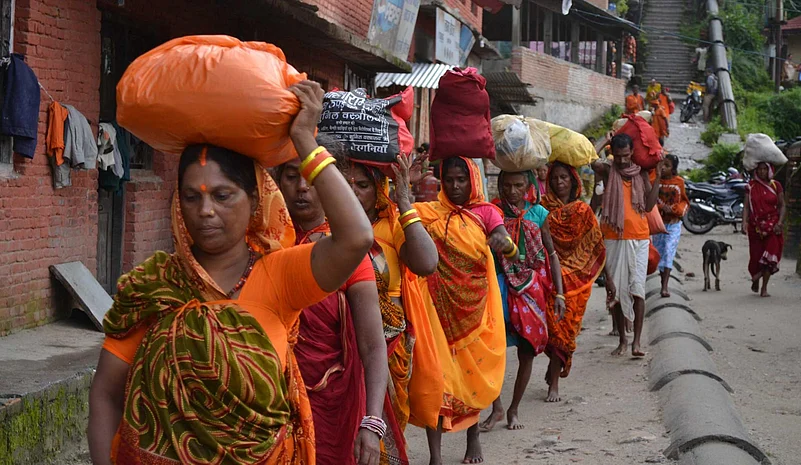Each year, as the month of Shravan (July–August) begins, a sea of orange takes over parts of Bihar and Jharkhand. These are the Bol Bam devotees, barefoot pilgrims carrying water from the Ganga in Sultanganj to the Baba Baidyanath Dham in Deoghar. Walking over 100 kilometers through rain, heat, and rough terrain, they chant just two words: "Bol Bam." It’s more than a religious phrase. It’s a rhythm of faith, a prayer in motion, and a voice for millions whose devotion lies not just in rituals, but in their feet.
The Legend Behind the Pilgrimage
The Baidyanath Dham temple in Deoghar is one of the twelve Jyotirlingas, which are considered the most sacred abodes of Lord Shiva. Legend says that the demon king Ravana, a great devotee of Shiva, wanted to take the lord to Lanka. Shiva gave him the Lingam on the condition that it must not be placed on the ground during the journey. But Ravana had to stop to relieve himself, and he handed the Lingam to a young boy (Lord Vishnu in disguise), who placed it on the ground. The Lingam took root, and that spot became Deoghar.
Today, the story is retold in every chant, every step taken by the Kanwariyas (pilgrims). The water they carry from Sultanganj’s Ganga is offered to the Shiva Lingam in Deoghar as a mark of that ancient devotion.
Why Do Devotees Walk?
At the heart of this pilgrimage is the idea of shraddha (faith) and tapasya (penance). The journey is a test of both physical and spiritual endurance. Walking barefoot for 105 kilometers with pots of water hanging from a bamboo stick (called a kanwar) is no easy feat. Many devotees even follow strict vegetarian diets and refrain from worldly pleasures during the yatra.
The saffron clothes, chants, and camaraderie among fellow pilgrims create an atmosphere that’s both chaotic and calming. Every "Bol Bam" shouted on the way is a reminder of the purpose, the destination, and the god waiting at the end of the road.
Types of Kanwariyas
Not all pilgrims travel the same way. Some, called Dak Bam devotees, complete the entire journey without stopping, running or fast-walking through the night. Others take several days, stopping at camps, dharamshalas, and community-run shelters that spring up just for the yatra season.
There are people of all ages, young boys, middle-aged women, even elderly men walking together. Some come in groups from their villages, while others undertake the journey alone, but never feel alone on the road. There’s food, water, music, and stories shared along the way.
Community, Economy, and Faith
The Bol Bam yatra isn’t just a religious event, it’s a social and economic movement in its own right. Entire towns along the route transform into rest stops, markets, and service points. Local vendors sell food, clothes, and religious items. Volunteers offer free meals, first-aid, and even massages. For small businesses and locals, it’s a time of high activity.
The Bihar and Jharkhand governments have also stepped in over the years to streamline the process. Mobile apps have been introduced, and medical camps, police patrols, and sanitation drives are set up to manage the enormous crowd. It’s a challenge, but also a moment when infrastructure is tested and community spirit shines through.
A Rural Expression of Devotion
What makes the Bol Bam yatra unique is that it remains deeply rooted in rural life. It’s not about Instagram posts or air-conditioned tours. It’s about the dirt roads, the village songs, and the raw power of belief. In an India that is rapidly urbanizing, this pilgrimage reminds us that faith still finds its strongest footing in the soil.
Many pilgrims are from small towns and villages of Bihar, West Bengal, and Jharkhand. For them, this journey is the year’s biggest spiritual moment. It's not just about reaching Deoghar, it’s about the entire experience: the friendships formed, the blessings received, and the sense of purification that comes with it.
A Living Tradition
Despite modernization, the Bol Bam tradition continues to thrive. In fact, with every passing year, the number of pilgrims seems to grow. Some say the hardships of daily life, like joblessness, poverty, and health worries, make the yatra a kind of escape. A few days on the road, surrounded by faith, gives people the strength to carry on.
Others see it as a personal promise. “I prayed for my child’s recovery. When he got better, I promised to walk to Deoghar,” says Ram Babu, a 38-year-old farmer from Samastipur. Stories like his echo across the route of gratitude, struggle, and silent hope.
The Bol Bam pilgrimage is one of India’s most heartfelt expressions of devotion. It’s not about luxury or comfort—it’s about putting your faith into action, literally step by step. The road from Sultanganj to Deoghar may be long, muddy, and tough, but for the Kanwariyas, it is sacred.
On their tired feet, the story of devotion moves forward each year. And at the end of the road, beyond the crowds and chants, stands Lord Shiva—silent, but listening.
Follow 해외카지노 Experiences:
| | |















